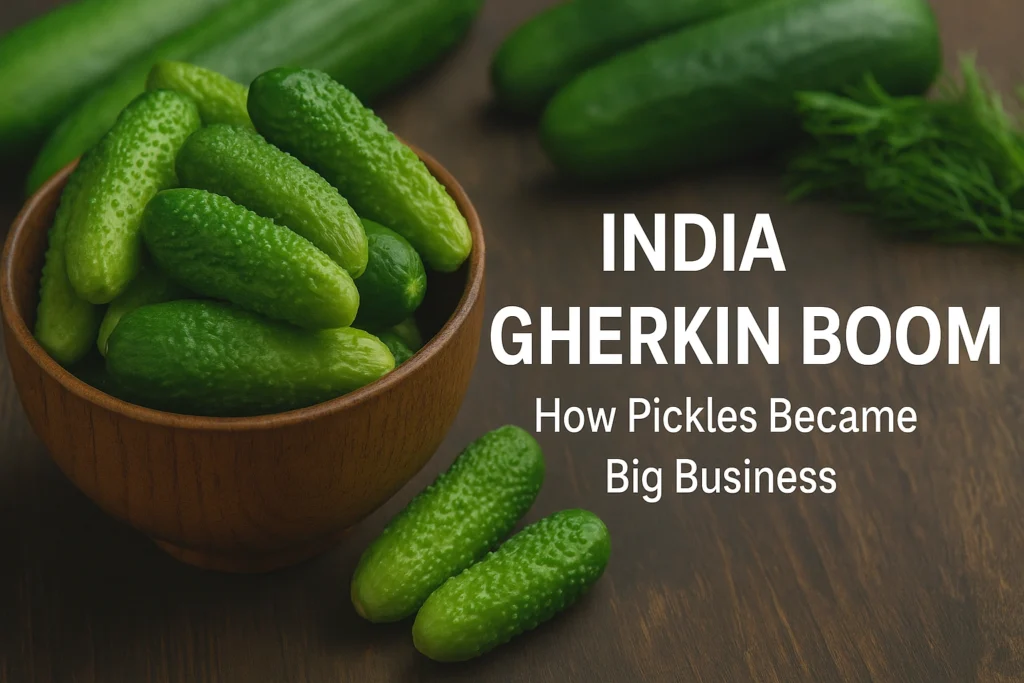Cucumber Gold: India’s Gherkin Boom and the New Agri Gold Rush

India’s gherkin industry is flourishing, turning farm-fresh cucumbers into a booming export business with rising global demand.
Not a Passing Trend, but a New Identity
The India gherkin boom is not just about numbers or exports—it’s about identity. A quiet crop, long overlooked, is suddenly earning its place on the main stage. What started in isolated farms in Karnataka and Tamil Nadu has now spread to states like Maharashtra, Madhya Pradesh, and even parts of the Northeast.
What’s more interesting is how this new wave has united unlikely partners—young agri-entrepreneurs in Bengaluru working with tribal cooperatives in Bastar, helping them optimize post-harvest processes. This sort of collaboration across class, geography, and language? It’s rare. But it’s happening—driven entirely by the promise of the humble gherkin.
Buyers Are Watching Closely
Global buyers aren’t just looking at tonnage anymore—they’re asking questions. What soil was it grown in? How was the water sourced? Were pesticides used?
Exporters are quickly realizing that the India gherkin boom must be sustainable to be scalable. That’s led to a rise in QR-coded jars where buyers can trace every pickle back to the village it came from. Some Indian exporters are already using blockchain to prove product traceability—especially for buyers in Germany and Denmark, where organic compliance isn’t just a label but a mandate.
This is turning Indian farmers into not just growers, but brand owners.India gherkin boom is real—and quietly rewriting the rules in farmyards from Maharashtra to Madhya Pradesh. This surging interest in pickles and gherkins isn’t a fad; it’s an opportunity, a shift in mindset, and a small‑town revolution. Let’s dive into how this surprising trend is rippling across global agri-markets, and why it matters.
Table of Contents
1. From Backyard Plots to Global Contracts
Not long ago, gherkins (aka mini cucumbers used for pickles) were mostly grown by hobbyists and small farmers. Today, entire villages—places where rice and wheat used to dominate—are converting fields for the India gherkin boom.
Why? Because buyers in Europe and the U.S. are writing long-term contracts, promising stable prices. One farmer in Chalisgaon, Maharashtra, told me: “I was squeezing in pepper and onion, but gherkins paid better and the buyer picked up directly from my village.” That’s real change—fewer middlemen, better margins.
2. The Numbers That Don’t Lie
According to recent trade data, India now ranks among the top five global exporters of gherkins, with shipments exceeding 120,000 tonnes in 2024. The sector is forecast to touch $800 million annually by 2028. In comparison, it was less than $200 million just five years ago.
At the same time, certified organic and greenhouse-grown gherkins are commanding premium prices—up to 40% extra in niche European markets. With numbers like that, the India gherkin boom isn’t going anywhere.
3. When Tech Meets Tradition
Walk through a gherkin farm in Jalgaon and you’ll find drip irrigation lines amid traditional fields—farmers have adapted old methods, but added precision. Mosquito nets protect young plants. Drones scout for pests. Private labs soil-test at half the cost.
Agritech cooperatives are emerging, helping farmers understand market standards in Germany or Japan. They build processing units, offer pre-funding, and manage export compliance. These aren’t big-city techies—they’re rural cooperatives, running small with big ambitions.
4. Pickle-Friendly Markets & Export Growth
The global pickle market is estimated at $6.2 billion, and growing at nearly 6% annually. But it’s the gherkin segment that’s outperforming all others—thanks to consumer demand in Europe’s colder climates, where fermented pickles are pantry staples.
Companies specializing in “pickle-grade” cucumbers are carving out niche supply chains. Exporters now talk of “India gherkin boom” as a unique selling point. It’s no longer just “Made in India”—it’s “Pickled in India,” and that story is selling in London, Berlin, and Chicago.
5. Stories from the Field: Farming with Pride (and Risk)
I sat with Lachhman, a third‑generation farmer near Bhopal. He’s diversified 20 acres into gherkins, with polyhouse tunnels. He’s proud. But not naive. “If the export buyer delays shipment, the fruit overripens in three days,” he says. “You lose half the profit.”
That risk is real. Yet even with crop failures due to heat spikes, Lachhman says he still makes 35% more by growing gherkins instead of traditional pulses. That’s why so many are jumping on the India gherkin boom—not for glory, but for their families.
6. Challenges: Not Everything Is Pickled in Sweetness
This growth story isn’t without hurdles.
- Price volatility: Global buyers might pull back demand.
- Standards compliance: EU regulations on pesticide residue and microbiology are tighter than Indian norms.
- Logistics: At rural cold-chain hubs, trucks often arrive late or are badly refrigerated.
Still, exporters are stepping up—in one cluster, farmers installed solar cold rooms to store produce for days.
Also check out (Can India’s D2C Brands Survive the Retail Juggernauts? )
7. What’s Next for the India Gherkin Boom?
Expect more micro-entrepreneurs in packaging and processing. Expect partnerships between global grocery chains and rural suppliers focusing on sustainability and traceability.
The next wave? Functional foods—pickles fortified with garlic, herbs, probiotics. Indian producers are testing recipes for health-conscious consumers abroad.
Meanwhile, government support under Agri Export Promotion & Operation Greens is offering subsidies and training—helping farmers register their brands and access digital marketplaces.
8. Why This Really Matters
📈 Economic uplift: Villages traditionally tied to mono-cropping are now funding kids’ education from farming profits.
🌿 Sustainability: Gherkins often require less water than vegetables like onions and tomatoes. And more income per drop.
🌍 National image: Pickles and jars from India become cultural ambassadors—a pinch of India, shipped worldwide.
In short, the India gherkin boom is small‑scale globally, but massive locally.
Also checkout (USDA Foreign Agricultural Service – India Gherkin Exports)





